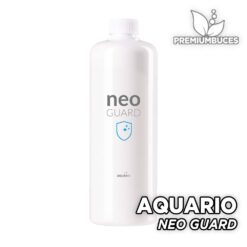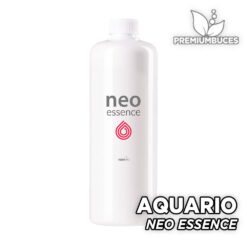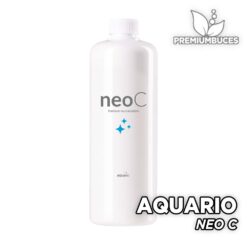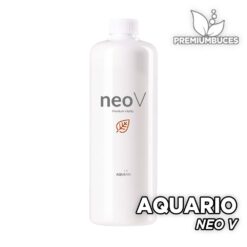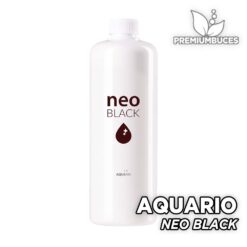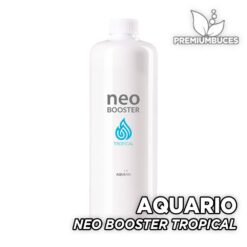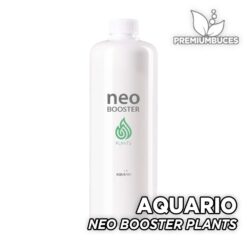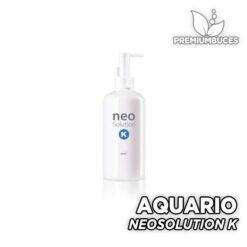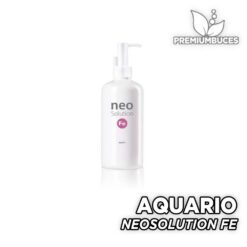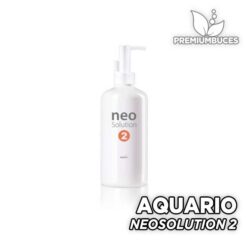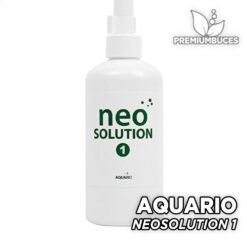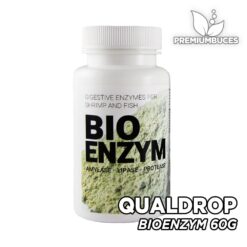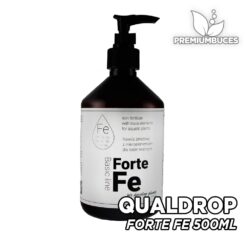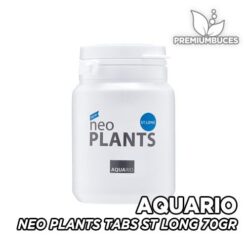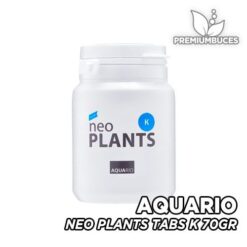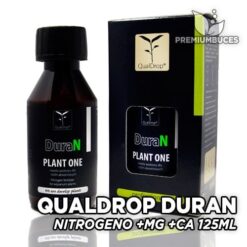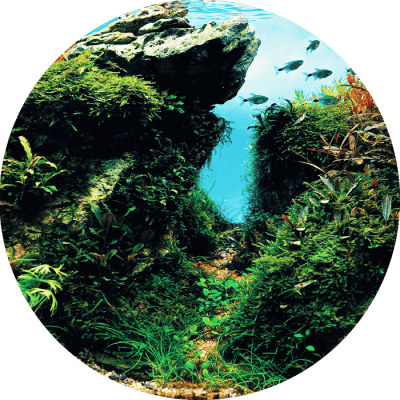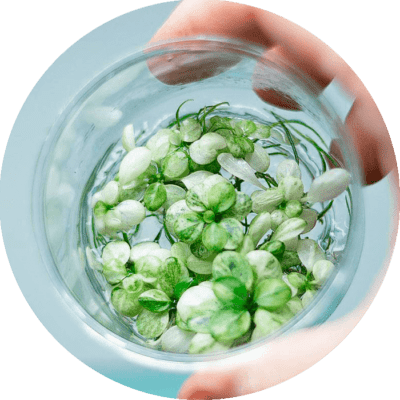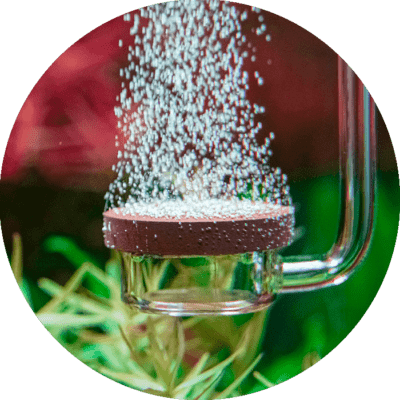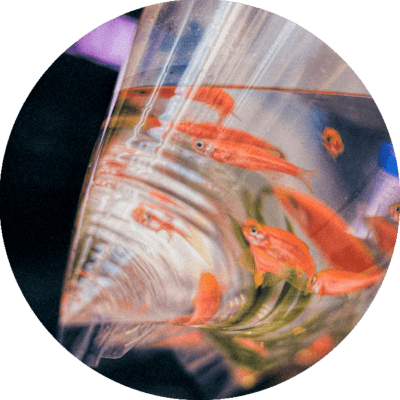Today we are going to talk a little more about the most awaited and exciting moment of the lives of the people who decide buy an aquarium to take care of him: this moment is when they reach their new habitat our pets, fish.
As we have already told you in other previous post, before it's time to introduce the fish into the water, there are mandatory processes that we have to go through: the aquarium cycling, about which we talk more in this article, and that basically consists of making biological filter have some bacteria that transform ammonium into nitrate, and then in nitrogen.
Addition constant monitoring of ammonium levels in the waterThere many other chemical parameters that we have to watch. The decompensation of some parameters as pH or KH, or the uncontrolled oxygen and carbon dioxide levels going to negatively alter the life of our fish and plants, and can even cause death.
In the moment in wich new fish arrive in our aquarium it is, in fact, when we have to be more delicate. Arrival cannot be quick Although it is what we want, and as you are surely imagining, it will entail a series of steps and points to avoid About which we are going to talk to you today in great detail:
Would you like to know what mistakes you should not make when welcoming your new fish? How to do so properly acclimate to their new home?
CAN WE INTRODUCE THE NEW HIT FISHES INTO THE AQUARIUM?
It is possible that some of you are reading this article very surprised, because you did not expect that the fish needed a mandatory process of acclimatization to the water of the aquarium.
If you have read other blog articles, you will know that they have to spend a few weeks and water quality tests until the first fish can be introduced, but perhaps you did not know that after that, also fish have to go through their own process introduction into the water.
El acclimatization process is not long, and as you will see throughout this post, following some easy steps, you can't go wrong. But the question is: Is it completely mandatory perform this process? And the answer is yes, and if we don't, chances are that our new fish get a shock caused by abrupt change that develops from the water in your bag or small fish tank to the water in our aquarium. This shock translates in the vast majority of cases in immediate death of the animal.
WHY DOES THIS SHOCK IN THE FISH OCCUR WHEN BLOWING THEM IN THE AQUARIUM?
The reason why all the fish, both those of fresh water as those of salt water, suffer this kind of shock if we do not respect their acclimatization process, is a purely biological reason: the fish they are ectothermic animals, or also called poikilotherms, and this means that they are unable to regulate their own body temperature a base produce internal heat on their bodies.
There are many animal species that they are capable of regulate temperatures to which your body reaches, as is, for example, the case of that reptiles. But fish do not suffer the same fate, and if they have managed to make their body acclimatize to the temperature and chemical conditions of the water from the fish tank in which they arrive at our house, at the time of changing them to the large aquarium, if we do suddenly, they will not be able to regulate their own temperature, which will cause collapse possibly leading to the death.
As you will see, it is a serious matter of respecting the acclimatization process, and that is why in Premium Divers we want to help you developing this definitive guide according to which you can dodge all possible failures to get the fish to enjoy and come to the aquarium with well-being, desire to eat and to develop and make you enjoy yourself.
THE IMPORTANCE OF WATER PARAMETERS
If you know and have certain experience in the world of aquariums, you will know perfectly what the chemical parameters of water and the importance they have. We have already told you before, and it is that fish need some specific conditions in the water adapted to your needs, and you also have to think about the needs of plants and vegetation in general that we have in the aquarium of our house.
They are usually the shops specialized in aquariums the ones that give us all the important information about each fish or plant that we take: what lighting they need what vegetation it suits them if they are fish and what fish it suits them in case of being a plant, the water temperature and parameters specific: some fish need a water that is very alkaline and others whatever very acidic and other species, as in the case of vegetation, moss in general, adapt more or less to any parameter.
The water parameters that a fish needs are dictated by the water features of its natural habitat. A certain species of fish or plant is accustomed according to its genetics to the waters in which he and his animal family have grown. However, there are also types of animals or plants that are perfectly capable of getting used to to many different chemical scenarios: an example is the moss Christmas Moss, who is capable of get used to any parameter needed by the fish you share an aquarium with.
So, in addition to doing the adaptation process of the new fish from the water in the bag or fish tank in which they arrive home, to end up in the aquarium water, you will also have to worry, of course, that in the aquarium the chemical parameters are within what the new fish need. Otherwise, they will quickly begin to show signs of discomfort, stress, or illness.
HOW TO KNOW WHICH TEMPERATURE IS THE IDEAL
We already tell you in another blog article that another of the problems that you will have to deal with once you have a aquarium with fish and plants inside is that of the rise in water temperature in summer.
El uncontrolled water temperature of an aquarium is one of the most harmful things for our pets: first of all because as we have told you, they are not trained the fish to have a regulation of your own body temperature. Secondly because when summer comes and the water temperature inevitably rises, this makes the oxygen disappears, Which is absolutely indispensable for the life of all living beings that are there.
This means that so that the new fish do not suffer the consequences of a sudden change in temperature when we arrive at the home aquarium, we have to think about achieve the same temperature than the water in which they arrive. As you can read in this article about how to change the aquarium water every two weeks when it is too dirty, and especially how to carry out this process without altering the chemistry obtained from water, new water has to temper, to get a temperature similar to that of our aquarium and thus not disturb the fish or the plants.
In fact, one of the most common mistakes that are usually committed when we want the aquarium water is no longer hot, especially in cities and areas of Spain where temperatures close to forty degrees Celsius are reached, it is putting ice or cold water in suddenly to lower the temperature. This will stress the fish, will cause a speed-up in your metabolism causing their life expectancy to be shortened and can even reach cause common illnesses like ICH, which gives the fish a characteristic appearance with white spots and that it is caused precisely by a bacteria arising from drastic temperature changes.
With this we want to give you a more specific idea of how important it is to take into account the acclimatization process of the new fish to the aquarium. We know of many cases of people who have decided skip this step because they had already taken the mandatory precautions regarding the water parameters and thought this was less important, and have suffered the consequences.
If you have already had the enough patience and work to cycle the aquarium, buy them materials needed to control the parameters and elements as harmful as chlorinedon't throw it all away throwing the fish into the water, because perhaps all the previous effort will not help.
THE IMPORTANCE OF LIGHTING
Throughout this article we have seen, firstly, the main reasons why it is not good for fish to change them from the water from the fish tank to the water of our aquarium at once, and also the possible consequences that can happen.
Later, we have told you what are the most important elements to consider: on the one hand the water parameters and on the other hand the temperature Of the same. The time has come to talk about another of the issues that we must also take into account in this acclimatization process and then tell you, in the most practical sense, what are the steps and forms where we can switch fish from one habitat to another.
This last issue that we must also take into account when we move our fish to their permanent home, is none other than lighting. As you already know light is a very important element of the aquarium: is the one favors the photosynthesis process plants do, therefore the one that collaborates in the arrival of oxygen to the water. It is also important for create a more realistic environment for fish in which there are the same light movements as in their natural habitat. In fact, in the event that there is no accessible natural light for the aquarium, they are usually buy artificial lighting equipment, like the ones you can find if you click In the next link.
However, fish also need a period of time of each day of darkness, as if it were the night. The darkness relaxes them and them helps in adapting to the environment, this on any day of your life in the aquarium. But most of all this darkness will come in handy for the process aquarium acclimatization in the case that they are new fish.
So that aquarium lighting, or rather the lack of it, will be a indispensable element for the adaptation process to the new water is successful. It is recommended, in fact, turn off the light to introduce the fish in the water (now we are going to explain exactly how to do this introduction) and leave it like this, off, for the next four hours. Slowly we can light up the aquarium again, but before that the fish will have to find peace and relaxation in your new habitat.
FRESHWATER FISHES VS SALTWATER FISHES
Before talking about the methods to which we must resort to adapt our new fish to the aquarium water, we have to do a little differentiation between the possibility that we have a freshwater aquarium o one of salt water.
Normally, the vast majority of people have a freshwater aquarium at home: this is because traditionally almost all the species of fish and plants that can be obtained in the stores specialized are of rivers or lakes and not from the sea. In addition, there is a merely practical question that makes it turn out a lot easier for everyone have a freshwater aquarium, what is it possible change with tap water, or with bottled water. Meanwhile, in the case of choosing a seawater aquarium, or jellyfish to have jellyfish, there will be acquire salt water constantly.
In any case, it is clear that there are many palpable differences between fresh water and salt water, and between needs of freshwater and saltwater fish. First of all, is that salinity will be one of the elements to take into account when a new fish arrives at the aquarium in case it is of salt water: it will be necessary to regulate it and adapt it to the salinity that he needs. Meanwhile if we have a fish in a freshwater aquarium we will not have this problem.
There are other parameters that are only part of the reality of one of the two waters: The football, for example, is a Absolutely essential chemical element in salty waters, and that we will have to take into account so that the new fish can adapt. Just so you know, the advisable amount of calcium is more or less 400 or 450 milliliters for each liter of salt water.
In the case of the adaptation of fish to fresh water, calcium does not have to worry us, but other elements such as magnesium, Part of water hardness or KH but that in those that are specifically sweet must be taken into account because its presence at very high levels can alter the growth of some plants or fish. Normally magnesium has to be in a amount of 5 to 10 milligrams for each liter of water, and it is, as you will see, an element to take into account when we put new fish in the aquarium.
So, ultimately, the difference between freshwater and saltwater fish is paramount to be able to perform a correct acclimatization to the new aquarium of both types of animal. Not only for the control of the specific parameters of each of these waters, but also because two main methods for such acclimatization, they differ precisely by the type of water.
All the two adaptation techniques or methods, as now we are going to tell you in more detail, they are the bag of water method and the drip method. He First of all of them is the one often used with freshwater fish, as well as the second in the case of saltwater fish. As it is much more common have a freshwater aquarium, and we have already explained these reasons, almost all the information regarding the introduction of new fish in the aquarium will refer to bag method.
Likewise, we are going to talk to you about both so that you have information about everything and so you can choose having all the possibilities on the table.
METHODS FOR THE ADAPTATION OF FISH TO WATER
So, we have come to the most important part of this article: Now that it is clear enough to us, let's hope, It is important to know all the parameters of the aquarium and how we should conserve them to preserve fish health, and how to monitor them much more closely When it comes to newly arrived pets, let's talk about the exact and precise methods to introduce the fish into the water of the aquarium.
The convenient thing, if we go step by step, would be that just before doing one of these two methods that we are going to talk about next, Let's test the most important parameters of the aquarium, to make sure everything is fine and save us future trouble: we can test above all that there is not much ammonia or much chlorine, and we can test it thanks to some of these products that you can buy if you click here.
Would also be convenient to know the amount of oxygen, or of carbon dioxide and, as we have said before, of calcium in case of being salt water and magnesium in the case of fresh water.
After this, we would have to turn off the light in case it is artificialEither move the aquarium away from the source of natural light, and leave it like that until at least four hours after the introduction of the new fish, and finally do one of these two processes:
INTRODUCTION OF THE PLASTIC BAG IN THE AQUARIUM
If you already have any previous experience with aquariums, you will know that normally in specialized stores around this world, they usually deliver the fish that you buy (especially if they are few or of the same species) in a plastic bag of a comfortable size for that given time from the store to home full of water. This water comes from the aquarium in which the fish have been until then, and who has the conditions, temperature and chemical parameters in which they have been well and need also for the future. On Premium Divers, in fact, we deliver in a special bag resistant to shrimps that are bought so that they can continue preserving the aquatic conditions they need. As well this is the case with mosses and plants.
This plastic bag it's going to be the absolute protagonist and fundamental piece in the acclimatization process of the new fish to our home aquarium. This is because what we will do to acclimatize our new fish to the aquarium, it will be leave the plastic bag full of water from the tent on top of the water in our aquarium, and it will stay floating.
THE BAG FLOATING IN THE AQUARIUM WATER
With This process what we try is that by means of contact of the water in the bag and the aquarium through the plastic they leave resembling and balancing and that the fish can get used to the temperature of our aquarium without it being in an abrupt way. The time of this process to leave the bag floating above the aquarium it should take about 15 minutes more or less, although it is more convenient that it be a little more time, up to 30 minutes, that less than the 15 minimum established. Another important detail that we have already said, but that we repeat due to its importance is that the aquarium should be dark by the time the bag is floatingSo that do not move the bag towards the light bulb and the fish get stressed.
We put a glass of aquarium water into the water in the bag
Once this time of the bag floating and acclimatizing to the new temperature, what we must do is cut the top of the bag with scissors, having a lot be careful so that the fish do not move too do not pour the water from the bag into the one in the aquarium: you just have to hold the bag open, take a glass cup y pour some of the normal aquarium water into the fish bag.
We do it two more times and with the help of a net, we throw our new fish into the aquarium
Once we pour this water, we waited 10 minutes and we observe the fish behavior. It is important do not pour the water abruptly, as we have told you fish are animals that get stressed very easily. At the end of these 10 minutes, We take the glass and pour another little water from the aquarium inside the bag and we waited another 10 minutes. Finally, after this time and seeing that the fish are well and act normal with the new water, we take a net and very carefully we leave the fish in the aquarium that will be your future home.
THE NETWORK: AN ESSENTIAL ELEMENT
This to use the network is not an arbitrary data, it is very important because what it cannot be done es dump the new fish directly onto our aquarium with the water that has accumulated in the bag after doing the acclimatization process.
This plastic bag water, which was originally the base on which we should create the perfect acclimatization for our new fish, it has been undergoing a degradation process over the last half hour in which we have carried out the bag method. Why this degradation? Because basically the fish have been coexisting for a long time in that small amount of water, surely they have produced waste y has been completely contaminated, so it is quite likely that it is a water with very high doses of ammonia that could seriously damage the parameters of the water in our aquarium, which has already done the aquarium cycling process and what it has are high nitrogen levels they do not harm the fish.
So, to make it easier to understand the simplicity of this method from the bag of water, we will summarize in a small outline that you will only have to continue to do it well:
- We test the water in our aquarium before starting the process.
- We turn off the artificial light, or we move the aquarium away from the source of natural light.
- We open the lid of the aquarium and place on the surface float the plastic bag with water in which are our new fish.
- We let stay like this for 15 minutes.
- We cut the bag from above, carefully, and with the help of a crystal glass we put some water from the aquarium into the water in the bag with the fish.
- We let 10 minutes pass, always watching the comportamiento of the fish.
- We return to pour a glass of water from the aquarium at home in the water of the bag with the fish.
- We let pass last 10 minutes.
- Very carefully and help from a network, we catch our fish as quickly as possible and we throw them into the aquarium that will be their home.
- We get rid of the plastic bag where they came from, and of the contaminated water that it still has inside.
And so you have already described perfectly the most used and widespread way of acclimating fish to the aquarium. When in doubt about what type of fish you have or what are the conditions they need, this will always be a good option to adapt them. In addition, it is the faster and easier way.
ACCLIMATION OF FISH USING THE DRIP METHOD
We have already told you that the previous technique, that of introduce the plastic bag with the fish directly into the water of our aquarium homemade is the most used by the vast majority of people. However, there is a technique most often used for saltwater fish and salty aquariums.
We had already told you before and there is a lot of difference in the chemical elements to take into account if we have a freshwater aquarium than if we have a saltwater aquarium. This is why, although the floating plastic bag technique is often used for any type of aquarium, true connoisseurs of the aquarium world and who have salty aquariums with sea fish, they also usually make use of this method What are we going to tell, and what is called the drip method.
For the drip method we will only need a couple of essential items: first a plastic container, like a bowl (which in fact it will be good for you to have in general for every time change the aquarium water every two weeks or so) and secondly a a kind of tube often called a non-toxic tube and that will be indispensable to make the drip.
This method starts in the same way as the previous one, putting the plastic bag with the new fish so that it floats for 15 minutes in the aquarium water and so the temperatures of both waters are balanced.
La difference between both methods starts at this point, And is that after these 15 minutes acclimatization, we must cut the plastic bag and pour its contentsi.e. new water and fish in a plastic container, like a bowl, completely apart from the water in our aquarium. It is important that the water covers the fish in this temporary container.
Then it's time to use the non-toxic tube, which can also be a hose or tube that is capable of regulating the amount of water that passes through. What we will do now will be pour into the temporary plastic container where are our new fish a constant dripping of water that comes directly from our aquarium. Ideally, according to experts, there are 3 drops of water for every second, and this is why it is important that the transfer instrument that we use has the ability to be measured by ourselves. Yes el cubo or plastic container where the fish are was filled because it is not a very large size, the ideal is gradually remove the water and having be careful not to move the fish too much so as not to stress them out.
It is also important that in this hour-long processlet's measure sometime the salinity level of our aquarium and the temporary container of the fish, to see if is balancing and also that it is neither too low nor too high.
So let us make you a simple and quick scheme to carry out this method:
- We measure the aquarium parameters before starting the process and we turn off the artificial lights, or we close the natural light source.
- We put the plastic bag with our fish and the water they have, on the water surface of our aquarium where it should float 15 minutes.
- We carefully remove the bag of fish, the we open and dump the fish and that water in a basin or plastic container.
- We put the non-toxic tube or hose with one end in our aquarium and the other in the fish bowl.
- We carry out a poor drip process but without any pause to gradually pour water from the aquarium into the fish bowl, for 1 clock hour.
- By the end, with a net exactly the same as in the bag method, we place our fish in the aquarium, that is, in their final location, and we dispose of the water from the provisional basin.
NEXT STEPS IN THE ACCLIMATION OF THE FISH: AFTER THEY HAVE BEEN PLACED IN THE AQUARIUM
Finally the time has come when our new fish are inside the aquarium that we have at home. It hasn't been so difficult, hasn't it? Of course they are fairly short and easy processesYou simply have to take them into account and not skip them.
And now that? It's a good question, because even though the fish are already in the aquarium we should not be disinterested now and go do other things. We will still have to pay a little attention to their behavior for the next few hours.
So that, what do we do now that we have the fish in our aquarium, and possibly alongside other fish? Well, let's summarize it briefly:
THE CONVENIENCE OF ADDING SOME CONDITIONER TO THE AQUARIUM WATER
Although just before the process of acclimatizing the fish to the aquarium we have measured the parameters and checked that everything is fine, It is possible that some water from the plastic bag has escaped into our aquarium. So, in case the flies, we recommend add a little conditioner or water conditioned with a extra bacteria that eliminate harmful chemical excesses for our fish, old and new.
About Us we recommend this conditioner that you can find in our online store, and that basically helps to improve the biological balance aquarium: facilitates decomposition of aquarium waste, What are the main culprits in creating harmful chemicals for the same, prevents the appearance of seaweed, which we have already told you before how harmful they can be and it also helps the Most fish survival.
AVOID FEEDING THE FISH WITHIN HOURS AFTER ACCLIMATION
How is it observe the behavior of the fish in the following hours at acclimatization of the new, We avoid feeding them in the next four hours to this process.
From this moment we understand that the fish have acclimatized well and that you can eat now y develop your life normally, but first we must leave to go through an analysis process in which if we feed them, they can change their way of acting and alert us for no reason.
OBSERVE IF THERE ARE TERRITORIALITY PROBLEMS BETWEEN FISHES
This is a step that it depends a lot on the type of aquarium that we are creating. In the event that these are the first fish to enter in the aquarium, in principle no problem should arise, especially if they are of the same species.
But if we are creating a community aquarium, the best we can do is observe that older and newer fish are interacting normally. Just so you know, a good trick in case we see any aggressive behavior or attack is change the decoration of our aquarium in a way: place things in other places and so perhaps they get used to it and they change their common spaces, and territoriality disappears.
CONCLUSIONS ON THE ADAPTATION OF FISH TO AQUARIUM
We have reached the end of article, where we hope to have transmitted well the importance of carrying out this small process of arrival of the new fish to our aquarium. Surely you know that each species of fish is a world, and what's up some that adapt to any circumstance without any problem, while others are much more sensitive.
Some of the most sensitive types of fish, so that you get an idea of the transcendent control of parameters and acclimatization to the new aquarium in case they are the ones you are going to acquire, they are the bicirris fish, also called crystal catfish, with which special care must be taken for their irratibility to changes in temperature and chemical characteristics of the water, or the sturgeon. You also have to have a special care with one of the favorite fish of aquarium lovers, What are the moorish idol fish, also called zanclus cornutus by the scientific community, and that they are very difficult in the sense of acclimatization to new habitats.
But even if the fish that you are thinking of acquiring are not in this small list that we have made for you, you should know that from Premium Buces We strongly recommend that respect all these processes we are talking about when it comes to having an aquarium. Check parameters, temperature and light and do to meet the methods of acclimatization of the new fish may seem like tedious exercises, but only they are saving us the later upset when we see sick fish, that they may even die, or that they do not finish acting as we wish underwater.
Once we have made the first processes and let's stop being beginners, everything these types of activities will be routine, a piece of cake that we won't even have to think about.
For any other duda, relevant information on this topic and others, you can write us through the comments. And if you want to know all our specialized products for the aquarium world, you can take a look at our online store and social media.

